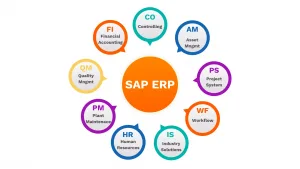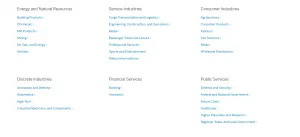Table of contents:
What is the SAP ERP system?
- Characteristics – definition and basic information
- Features – typical system components and capabilities
- Benefits of implementing the SAP ERP system – significant advantages from the entrepreneur’s point of view
- Which companies can benefit most? – typical industries using ERP systems
- Comparison with other ERP systems – SAP against similar solutions
Versions of the SAP ERP system
- SAP ECC – description of the legacy version (still in use)
- SAP S/4 HANA – description of the latest version
- Differences between SAP ECC and SAP S/4 HANA – comparison of both variants
- Benefits – advantages of the S/4 HANA version from a business perspective
What is the SAP ERP system?
Characteristics
Basic information
An ERP (Enterprise Resource Planning) system is a type of software used for the management of resources and processes taking place in a company. It usually consists of applications (modules) responsible for specific areas of the company’s operations (accounting, logistics, sales, HR, analytics, etc.), capable of carrying out transactions, placing orders, and controlling other processes.
SAP ERP is a product developed by the German company SAP SE. It is a pioneering software solution distinguished by its complexity, enabling adaptation to virtually any enterprise.
SAP ERP, and above all the S/4 HANA version, was designed for large, international companies focused on scaling and process unification between their branches. The system works best where business processes are highly complex and require global standardization.
Features
- Structure
- Integration of company processes
- Real-time data for all users
- Process automation
- Personalization
Structure
The SAP ERP system consists of three layers: database, application layer, and presentation layer.
The database – one for all modules – stores information used by the SAP software. It can be viewed, updated, archived, or deleted. It is, therefore, important to implement safeguards that prevent unauthorized persons from accessing this deepest layer of the software.
The application layer deals with processing user requests – making changes, recalling data, or generating reports. In theory, one application server is required to process a request, in practice there are many. In order for a request to be handled as quickly as possible, it is always sent to the server with the lowest current load.
The presentation layer contains the user interface. Its requests are sent from the presentation layer and then processed by the application layer. Next the required data is taken from the database, processed, and finally displayed back in the presentation layer. This allows even non-advanced users to work with the system without going into the lower, more complex layers of the software.
| In earlier versions of the system, logical operations (such as processing requests for data preparation) were performed by the application layer. In the latest version of SAP ERP – S/4 HANA – it is different. Operations are carried out in the database, and this is because HANA – a database created by SAP – is a powerful tool and performs this task much better and faster than application servers. Why? – this will be explained in the Versions section. |
Integration of company processes
SAP ERP is a single system that supports the entire enterprise and integrates all its processes. In an average company, different software solutions with their own databases are responsible for different areas, which makes communication between the systems very limited or even non-existent.
All modules and applications included in SAP ERP are based on the same database – which means that they all have access to information from every transaction carried out by the company.
As a result we have access to the cross-section of the entire company’s processes from the level of the ERP system. This lets us make decisions based on a complete data set, rather than just a single section. Integration also facilitates communication and collaboration between departments.
It is worth adding that thanks to a very wide range of modules included in SAP ERP, entrepreneurs do not have to look for additional functionalities outside the system. Especially since applications can be implemented into the system at any time, if necessary.
Real-time data for all users
The system is designed to operate in real time, not on historical data. This means that the data is updated on an ongoing basis – there is no need to download anything or spend precious time on updates whenever you want to perform any operation in the system. As a result, the entire company operates using up-to-date data, and employees can, for example, react immediately in the event of a sudden shortage of production materials, order withdrawal, or transaction interruption.
Process automation
Accounting is done automatically in the Sales and Production modules. All transactions are immediately reflected in the system, and employees can access them instantly. This significantly speeds up response and decision-making, for example related to the ordering of goods.
Personalization
One of the biggest advantages of SAP ERP is the ability to adjust the solution to even the most specific company requirements. On the one hand, it enables a very wide selection of modules and applications, and on the other – it offers excellent software modification capabilities.
In the hands of experienced ABAP consultants and developers, the SAP system is highly flexible. It is entirely possible – and often practiced! – to introduce modifications thanks to which all processes taking place in a company are reflected in the software. This requires an investment of time during the pre-implementation audit period<link?>, but it is worth doing. Identifying the company’s needs and adjusting the system accordingly helps avoid the disappointment faced by many entrepreneurs who implemented their systems too quickly. SAP ERP is an investment – you should approach it calmly and consciously, so that the system can provide support for development and constitute the beginning of digital transformation, instead of becoming an unnecessary expense or difficulty.
Benefits of implementing the SAP ERP system
- The same data no longer has to be saved multiple times
- Extensive analytical systems
- Opportunity to reorganize the company
- Cloud solutions
- The system grows with the company
- Better internal communication
The same data no longer has to be saved multiple times
Each piece of information – a transaction, invoice, order – needs to be entered only once to make the data available throughout the system. This is the result of integrating all modules with one another and using a shared database for all applications. Employees no longer have to waste time repeatedly entering the same information or searching for the necessary data in different systems.
Extensive analytical systems
The SAP system enables the creation of reports on the basis of the data of all transactions taking place in a company. Such a holistic approach allows for the preparation of comprehensive analyses – based on the activities of the entire enterprise, not just its sections. This facilitates making the right decisions – both strategic, crucial for the entire company, as well as daily, related to the time of order placement or starting production.
The analytical modules allow any user of the system, even non-advanced, to create or read reports generated in real time on the basis of cross-sectional data. What is more, the S/4 HANA tools not only present the current condition of the company, but also create forecasts based on predictive analysis, and thus indicate areas with room for improvement.
Opportunity to reorganize the company
We have emphasized several times that SAP ERP can reflect every business process that takes place in a company. However, it is worth realizing that not every process is worth transferring to the system exactly in its present form. The implementation or conversion to S/4 HANA should be used to analyze all activities and optimize them so that the system includes everything that the company needs to operate, without technological debt or errors repeated over the years.
Accounting and settling differences between goods received notes and invoices constitute a good example. For employees, this often means laborious corrections and settlements in separate spreadsheets. It is possible to transfer this process to the SAP system, but it is not necessary, because the standard system includes solutions that deal with this problem faster and more efficiently. In S/4 HANA deviations are handled by the material ledger, which performs all calculations and booking automatically. The software not only takes over the duties of employees, but also significantly improves the entire process.
We can find thousands of such areas and activities in every company. With the help of experienced SAP consultants, the implementation of an ERP system is an opportunity to reform the company so that it works faster, with the software serving as support, not a burden. Automating processes and deepening analysis, in turn, allows the company to become more competitive and more efficient.
Cloud solutions
S/4 HANA is available in an on-premise version as well as in a cloud-based or hybrid version. We will discuss the differences between the two versions in more detail in a separate subsection /link to a new article here/, and here we will focus on the direct advantages of the cloud for an enterprise (as a predefined solution).
Cloud implementation is a faster option based on pre-defined configurations, ensuring lower expanses for IT system support, faster access to improvements (quarterly instead of annual, which is used in the on-premise version), and subscription-based payments. This solution provides many advantages to companies which require fast implementation. The consequence of such a scenario, however, is the need to adapt the company’s business processes to predefined solutions.
The system grows with the company
No enterprise stands still, so when deciding on an ERP system, you must take into account its flexibility. SAP ERP evolves along the changing processes of a company – the producer offers many modules that can be added or disconnected depending on the needs. New applications and solutions can be added at any time, even after the system implementation stage is completed.
Better internal communication
SAP ERP is the integration of all business processes in an enterprise. As a result, all communication, reporting, and transaction accounting can be closed in a single system. This helps eliminate the risk of omitting data, failing to book an invoice, or skipping an order. If an incorrect value is entered, the system will notice that the data does not match similar information and will return an error – so that the mistake can be corrected immediately.
Result? Improved communication, elimination of errors caused by the lack of integration between systems, and reduction of errors related to the so-called human factor.
Which companies can benefit most?
SAP ERP is suitable for medium and large enterprises, both private and public. The solution works well with a larger number of employees as well as when centralizing the work of numerous branches located in different places around the world and in different time zones. Companies that handle multiple processes (production, logistics, sales, finance, etc.) can benefit from the extensive modular offer and integration of all transactions within one system.
SAP ERP is the most popular choice of logistics and manufacturing companies. It is also frequently chosen by companies whose business partners and contractors also use SAP solutions – this enables convenient integration and instant data exchange.
However, this software will prove useful also in other industries – the range is much wider. Below we include a list of currently supported sectors [as of April 2021]:
Comparison with other ERP systems
Solutions competing with SAP ERP can be divided into two groups: niche and comprehensive.
Niche solutions are usually designed to support specific industries or processes (for example, online sales or warehouse management), which makes them unsuitable for large enterprises with many complex activities. They are also not very popular among consultants, which makes it difficult to find specialists to support a given system.
Universal solutions, similarly to SAP ERP, cover a wide range of processes taking place in companies. For this reason, SAP products work especially well in companies looking for the possibility of standardizing complex processes and scaling.
SAP beats its competition with efficiency and the ability to standardize processes between branches in different countries – thanks to which the entire company functions in the same way, regardless of cultural or legislative differences. On the other hand, it is believed that – compared to its competitors – SAP has a higher degree of complexity, which extends the time required to adapt the solution before launch. However, is this really a disadvantage?
The ability to adjust SAP ERP to the most client-specific needs is at the same time the greatest advantage of this software. An experienced consultant is able to modify the solutions existing in the system so that they fully meet the client’s needs. In this respect, the SAP ERP system is very flexible. It is really worth taking the time to adapt it to the company’s requirements – as a result the software will be able to actually improve the company’s performance, streamline its processes, and then grow with it. The complexity of the system is the greatest opportunity for an entrepreneur to implement truly tailor-made software.
Versions of the SAP ERP system
SAP ECC
SAP ERP Central Component is an application for enterprise resource management written in ABAP. Its latest version is 6.0 – the software will not be developed further. SAP ECC replaced the R/3 version in 2004.
Compared to SAP R/3, which operated in the client-server model, SAP ECC is based on a web application server. This means that users can work with the database not only using software installed on their computer, but also through a web browser. In other respects, the ECC version was an evolution of the previous solution rather than a completely innovative creation.
In 2027 the producer will stop supporting the ECC system in all of its versions – so it is necessary to migrate to S/4 HANA by then.
SAP S/4 HANA
The producer’s goal was to create a solution that would enable real-time data processing. The result of the works – S/4 HANA – was released in 2015.
The latest version of SAP ERP consists of two elements: the S/4 application and the HANA database. Both components operate based on the SAP HANA platform supported by in-memory database technology. What makes this version of the ERP system revolutionary is the database – based on in-memory instead of on-disc data storage, which was used in the previous versions of the software. This helps maximize the speed of operations performed on data.
In order to take full advantage of the capabilities of the HANA database, many elements of the ERP system have been rebuilt. The changes and innovative solutions used in S/4 HANA are presented below.
Differences between SAP ECC and SAP S/4 HANA
Database – lighter, faster, more efficient
Previous versions of SAP ERP systems could run on any database; the latest version works on SAP HANA only.
SAP HANA is much more than a database – it is a powerful engine that enables not only data collection, but also its efficient processing and presentation. Basing the ERP system on such a multifunctional tool allowed for a significant acceleration of processing.
Data storage
HANA uses in-memory processing. Data is written to and retrieved from hard drives, but read from RAM.
HANA uses column stores for data storage. This solution shortens the time needed to search for specific information in the system, because only the columns related to the query are taken into account, instead of all of them one by one – as in the case of row storage. In addition, since column storage requires less resources, finding data becomes less system-intensive. In short – it is faster and cheaper.
The storage of data in the highest level of detail is also an interesting solution. In other databases information is stored in the type of tables needed for the operation of individual modules. This means duplicating information and thus wasting space and resources. In HANA, data is not duplicated – if a specific module needs less detailed data (for example: total transaction cost for the whole year, instead of individual payments for each month), the database calculates it and generates the desired table. Although it sounds like a recipe for reducing system performance, the process takes a few seconds thanks to in-memory processing. What is more, by eliminating the stored tables, the database is much lighter – which means more space.
Processing
HANA is a powerful tool capable not only of storing huge amounts of data, but also of instant processing – by reading information from the main memory instead of hard drives. The result is a significant reduction in the time required to prepare reports or generate tables. This is best illustrated by an example – S/4 HANA can shorten the month-end close process by 60%, from ten to four days.
The enormous computing power of HANA enables the use of parallel processing – conducting several computing processes at once. It also allows for the use of Core Data Services (CDS) – an infrastructure in which data models are stored and processed in a database instead of an application. Instead of saving tables and wasting resources on storing them, the database generates them when they are needed for the application to operate. The process is lightning fast, with the added benefit of freeing up resources and reducing base maintenance costs.
Because HANA is such a powerful tool, many of the tasks previously performed by the application layer have been transferred to the database. This further increased the efficiency of the ERP system.
System integration
A very important change in the new version is the integration of multiple systems and applications. This applies to ERP system modules, other SAP solutions, as well as software developed by other producers.
In ECC individual systems – such as ERP, APO demand planning, EWM warehouse management – worked independently of one another. This hindered the data flow as well as the use of intersecting functionalities.
In S/4 HANA all the systems are integrated into one solution. The combination of data structures from different modules (FI, AA, CO, CO-PA) into one ACDOCA table minimized the number of aggregated and index tables, and thus – significantly reduced workload and maintenance costs. In addition, it made working with the system easier and enabled full use of the advantages of the Fiori interface.
As a result, the basic application of the ERP system covers most business processes and becomes almost universal. The product can be personalized, but tailoring the solution to a company’s needs relies more on implementing and modifying additional applications, rather than reworking the “core” of the system.
Apart from internal integration, S/4 HANA also allows, to a much greater extent than the previous version, external integration – both for other software from SAP as well as for applications from other producers.
New and improved functionalities
In S/4 HANA we can find solutions known from the previous version of the SAP ERP system – many applications have been improved to take full advantage of the software’s capabilities. There are also completely new functionalities. So what has changed in the system with the release of its new version?
- The interface, thanks to the use of the Fiori user environment. This change is so important that we dedicated a separate section explaining the details – you can find it below.
- Another advantage is the use of OLTP and OLAP in the same system, which enables real-time reporting and forecasting.
- Data tables from the FI, AA, CO, CO-PA modules have been integrated into one common ACDOCA table. This is how SAP reduced the number of tables, and thus – freed up system resources and accelerated the processing of information between modules.
- The Material Requirements Planning (MRP) module can now be launched and used while the system is running – it works in real time thanks to the computing power of S/4 HANA.
- In the area of logistics, a new element for inventory management has been created, which eliminates almost 30 tables used previously.
- In finance, a single field stores both general ledger accounts and cost elements. Thanks to this change, closing a period will be much faster.
- Activation of the material ledger is obligatory in S/4 HANA. This solution enables the settlement and automatic booking of any price deviations of materials and finished products. Additionally, the software valuates inventory in multiple currencies, which is important for global organizations operating in multiple countries.
- The Supply Chain Planning (SCM) module is now built into the ERP system as a core feature of Extended Warehouse Management (EWM). The module enables immediate reaction to market needs – both thanks to the extensive planning area and the ability to cooperate with partners using the software.
- The human capital management module was replaced by the extensive SAP SucessFactors solution.
- The supplier relationship management module was replaced with Ariba software – a B2B cloud-based purchasing platform.
- Central Finance and Cash management, i.e. two completely new functionalities that allow for automatic risk and credit limit calculation using built-in mechanisms.
- A new data warehouse has also been established – BW/4HANA. The system allows for direct reporting of data from source systems, and the introduction of a new architecture simplified the model and accelerated loading times.
Benefits
Speed
The most striking change compared to ECC is how fast work with S/4 HANA becomes. Thanks to the powerful database, reports are generated in real time – this means that you no longer have to wait a few hours to create a report, but only a few moments. This leads to improved flow of information and saves employees’ time. The impact on resources is also important – using the latest version of the system is simply more profitable.
Real-time operation
However, the change in the speed of work is not just about generating reports. All system work – processing and retrieving data, recording modifications introduced by employees, everything happens in real time. This shortens the time needed to perform every action even several times.
Simplicity
Simplification of process handling is a huge benefit – especially in the case of those processes that can be performed through the Fiori interface. Thanks to the unified appearance of individual systems, employees do not have to learn to operate each of them separately. Another improvement is the search engine that searches the data in the entire ERP system, not only in the section related to a given module.
Reporting in S/4 HANA has been significantly simplified. Thanks to Embedded Analytics, every system user can prepare a report on their own, and does not need support from the IT department. If a task that has previously been performed by two people is now done by a single person – it saves 50% of the time.
Cheaper maintenance
Increasing the independence of employees in the ERP system saves not only time, but also company expenses: efficient software supports the productivity of employees, allows them to focus on their own tasks, and perform them faster.
S/4 HANA helps save resources. The software does not stress infrastructure as much as the ECC version. What is more, because the data in the HANA database is stored in the main memory, and not on hard drives – the company does not have to invest in expanding the infrastructure necessary for data storage.
The use of main memory instead of physical disks also has an additional advantage. It reduces the costs of interface configuration, hardware purchase, and its subsequent maintenance.
Interface
The Fiori interface is an important distinguishing feature of S/4 HANA . In a narrow sense, Fiori is an add-on to the ERP system, significantly improving work thanks to its intuitive appearance. More broadly, Fiori is an open set of applications, constantly developed by the manufacturer. The Fiori applications offer excellent capabilities in terms of personalization and adaptation of the ERP system to company needs.
Unlike the GUI interface, Fiori is intuitive. The applications needed by the user (selected for their role in the organization and the tasks they fulfill) are presented as tiles on their home screen: the cockpit. Thanks to lightning-fast data processing, the numerical data presented on the tiles is updated in real time, so one glance at the cockpit is enough to notice any changes (instead of searching for them in the system using GUI).
The great advantage of Fiori is that it allows access to the ERP system from any device, as long as it has Internet connection. It is possible to work from a computer as well as a tablet or even a smartphone, so the system can be used from virtually anywhere – an office, train, or cafe.
More about the differences between GUI and Fiori, the business value of this solution, and its capabilities can be found in the article about SAP Fiori.
You have a question that was not answered in the article above? Contact our consultant via chat – you will get a response within a few moments!
The material was prepared in cooperation with Kinga Moska and Kamil Suszko.
Kinga Moska – Service Delivery Executive in the SAP Application Team at Hicron, SAP Champion, associated with the academic community of the WSB University and the Wroclaw University of Economics and Business. Manager by calling and passion.
Kamil Suszko – SAP BASIS Team Leader at Hicron. Efficient, qualified manager with proven experience gained in the information technology industry. Master of Computer Science and Econometrics at the Wroclaw University of Economics and Business.







